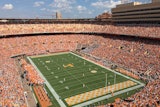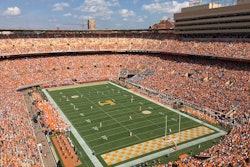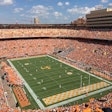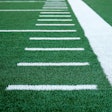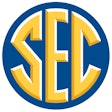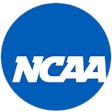Athletic Business celebrates 20 years in business by revisiting some of the authors, advertisers, topics and products that contributed to the magazine's early success.

Download PDF
26 ATHLETIC BUSINESS January 1997 O u r W o r ld , O u r W o r ld ,
January 1997 ATHLETIC BUSINESS 27 With this issue, Athletic Business begins its twenty-first year of publication. In geological terms, 20 years is not a long time - Kevin Costner aside, human beings haven't grown gills in that time, for instance - but there are subtle differences between 1977 and 1997.
Consider what the world looked like when AB first came on the scene as Athletic Purchasing and Facilities. Distrust in government in the wake of the Watergate scandals was sufficient to allow a Georgia peanut farmer to ascend to the presidency. The Cold War dominated geopolitical discourse, and not even an accident at a stateside power plant could sidetrack the proliferation of nuclear power and arms. The recent Arab oil embargo, meanwhile, was increasing interest in conservation and the development of alternative forms of energy. The inflation rate had gone over 10 percent and was showing no signs of dropping.
Culturally, it was the decade of bad taste in fashion and music. Peter Frampton had just Come Alive, Saturday Night Fever was sweeping the nation, and after two seasons of reshaping late-night television, "Saturday Night Live" had already begun its 19-year slide into irrelevance.
Twenty years ago, the athletics, recreation and fitness world looked a lot different. Jogging was a national craze, as was tennis. Baseball players had just gained free agency and Americans were appalled by the first $1 million contract. Women's sports participation at the college and high school level was expanding rapidly in the wake of the passage of Title IX in 1972. Aerobics, stair climbers, in-line skates, the Jane Fonda workout - these were things of the future.
That said, as the following pages will demonstrate, revisiting AB's beginnings shows how much of our world looks the same as it did in 1977. The fights to attain gender equity and promote accessibility to all are far from over. NCAA institutions are still struggling to put their finances in order. High school athletic departments remain underfunded.
Product liability reform is still being debated. Groups of entrepreneurs have high hopes for women's pro basketball and professional soccer, just as they did 20 years ago. On the other hand, hair styles, thank goodness, have changed.
We're elated to still be here after Betamax, rotary phones and disco have all been consigned to the dustbins of history. Our hope is that this glimpse into the past will allow you, and us, to take pride in the industry's accomplishments over the last two decades, and inspire us all to take care of our unfinished business.
By Andrew Cohen
A N D Y O U R S Illustration by Shola Friedensohn
28 ATHLETIC BUSINESS January 1997
[Product Liability] The Case For Reform "Senate to Consider Product Liability Act," read a headline in our April/May 1977 issue, at a time when the sporting goods industry was forming its first multiaction committee on liability. Four years later, with the issue still embroiling Congress, a member of that coalition, the Sporting Goods Manufacturers Association, tabbed Maria Dennison (previously a member of John Connolly and Ronald Reagan's campaign team) to open a Washington, D.C., office to house the association's full-time lobbying arm. Now Maria Stefan, she serves as SGMA's executive director.
Q Was product liability reform your primary focus initially.
A One of them. The issues of the day were not very much different than the issues now: product liability, eliminating non-tariff barriers to trade between the U.S. and Japan, getting criminal penalties attached to counterfeiting legislation and pushing for the extension of daylight savings time, which we were successfully able to accomplish.
On product liability, we really had a presence in the halls of Congress and in the floor of the hearing room. We had our manufacturers there three or four times a year testifying on the issue. But we also tried to cover the issue from the grass-roots side. One of our efforts was to develop the concept of CAPS, the Coalition of Americans to Protect Sports, which today does clinics around the country that are educating hundreds of thousands of coaches - and, more than that, our text is being used in colleges to educate those coming out of sports law and sports management curricula about the problems and opportunities faced in this arena.
So we've gone full circle with that battle, from making a stand in Congress to paying attention to our own house to working with allied organizations like ACSM, with whom we've been talking about forming a national injury database. Something I think we've made great strides in is participation in ASTM committees, helping to set standards for sports equipment. When I look back to 1981, we may have had three or four manufacturers involved, and now we have 250.
Q With all this progress, do you still see a need for legislation.
A I think the way we're going gets us more immediate results. The point of the legislation is that if you eliminate this patchwork of laws in different states and establish standards, then you'd reduce frivolous suits because there would be a penalty for engaging in such actions when you had no basis for them in law. If we want to reduce the cost of insurance and return some predictability to the costs that a business is going to have to assume, we need some standardization in law.
Q What are the odds of succeeding before AB's 40th anniversary.
A I think as long as you have the political action committees and trial attorneys, as long as you have the Senate and House being made up of a majority of trial attorneys, it's going to be difficult. I think, however, that the biggest problem facing us is one that is internal to business. We've been fighting the battle for so long that people are turned off. How do you excite people to make the phone calls, write the letters and believe that the opportunity for passage of this law is possible.
What the opposition has done is scare people that their right to sue is going to be taken away from them. And that is an untruth. There is no one in this country, no entity, no organization that can eliminate the ability of an individual to sue.
Q Can that be overcome.
A The more businesses have to pay for insurance, the more they're not going to be able to get insurance, the more they find themselves in front of a court on frivilous issues, the more they're going to want reform to happen.
But the employees of those businesses have to make their voices heard as strongly as those on the consumeractivist side have made theirs heard.
Congress responds to votes. You can't just rely on a coterie of lobbyists. You have to have that army behind you, and you have to show the strength of that army in order to succeed.
[Instruction] Slings of Outrageous Fortune The January 1979 issue included an item about materials the National Catapultry Association was making available to schools and recreational institutions for teaching slingshot shooting. "Catapultry is an ideal sport for developing hand-eye coordination, muscle tone and perception skills," the item read, "and requires a minimum of equipment or setup expense." Perhaps it was the potential liability expense that kept catapultry from being given tournament status in the nation's schools.
[Product Update] I Can See Clearly Now Pro-Tec Inc., now defunct, was responsible for this early eyeglass protector for racquet sports players, but nowadays, contact lenses and prescription protective eyewear have largely sent such contraptions to the sideline. The only over-the-glasses model still in existence, the Vision2 from Leader Sport, has fortunately received a makeover. Leader's Craig Schmidt says his company manufactures it partly because no one else does, making it the only option for people who don't wear contacts and would rather pay around $40 retail than purchase an expensive pair of prescription sport lenses. "It has a niche out there," Schmidt says.
ATHLETIC BUSINESS: 1977-1997
January 1997 ATHLETIC BUSINESS 29 In the late 1970s, Phoenix attorney Rick Ball defended Bike and Riddell in several high-profile helmet-litigation cases. Ball now describes himself as "a retired sports trial lawyer, and until a big plaintiffs' case comes along, I'm going to stay retired. When it does, I'm going to unretire and pay for my retirement."
Q How would you characterize the last 20 years of product liability reform.
A There has been virtually no result in terms of legislation at the federal level. A few state statutes have been adopted that are helpful to manufacturers, but those are a benefit only in terms of injuries occurring and lawsuits filed in those states, and there's no uniformity among them.
At the time, helmet manufacturers, but also trampoline and gymnastics manufacturers, were having a difficult time. There were 15 football helmet manufacturers, and then the rather monumental verdict against Riddell in 1975 received a lot of national publicity and resulted in an awful lot of follow-up litigation. Now there are two football helmet manufacturers.
Q Why hasn't the push for reform caught on.
A In my view, the general public does not want to see significant limits placed upon its ability to receive compensation for injury. The U.S. Constitution guarantees us that right, and that's one of the reasons the courts were created. I'm not sure how much the general public's voice is heard in Washington, but I can tell you that at the state level, when legislatures begin to seriously consider interfering with people's ability to recover for injuries, people stand up and shout. In Arizona, we have had three different referenda or initiatives attempting to severely limit people's rights to recover, and they have been absolutely crushed at the ballot box. Whether that's out of a broad social concern or a selfish desire to preserve a sort of lottery in case you happen to get the ticket, I don't know.
Q Still, Republican legislators are pushing the issue.
A And have been, since 1976. The political side of it is that until two years ago, there hadn't been a Republicancontrolled legislature in all that time, and never in those 20 years had there been a Republican-controlled legislature and a Republican president.
Whether it is, again, the influence of the trial lawyers or a socio-political philosophy, Democrats have not traditionally been willing to severely impede people's right to recover, while Republicans have been very concerned about protecting big business and industry.
Another factor is there is a limit on the ability of Congress to restrict the right to sue in state court on state matters. They have the right to make laws that have to do with interstate commerce, and they can restrict the right to sue in federal court. But most product liability litigation is brought in state court. So a federal law wouldn't necessarily have the broad-based impact that a lot of people seem to believe it would have.
Q What has been the trend in injury litigation.
A My sense is that manufacturers aren't dealing with litigation in anywhere near the volume they were from 1977 to 1985. Part of it I'm sure is that the equipment isn't so easy to attack.
Also, the helmet industry got their act together and figured out how to defend those claims, and plaintiffs' lawyers are not looking for hard cases. So there's been a dropoff in litigation, but it has not by any means gone away.
Is it still a significant problem. You bet. Is there a way legislatively to make it go away. Personally, I don't believe so. I said that in 1977, that the industry is pouring money down the drain, and I think the wiser course would be to use all this money to educate parents, athletes, administrators and coaches how to reduce risk, where the real responsibility for injury lies - and sometimes the responsibility for injury lies with the nature of the game. I defended several cases where a paralyzed athlete had his head driven into the turf while attempting to make a tackle. The responsibility for that injury was the nature of the game; nobody did anything wrong. People need to understand that, and they don't.
And the need for education is ongoing. There's an interesting dynamic that's taken place in football with regard to quadriplegia. If you carefully monitor the statistics, you'll see that there was a dramatic drop in football quadriplegia beginning in 1977, it really leveled off in about 1981, and then began to drift back up again around 1990. If you take those numbers and correlate them with the typical age and longevity of high school football coaches over the last 15 years, you find coaches aren't staying in it for 25 or 30 years as they did 25 years ago. Today, you have an awful lot of young coaches who weren't really part of the educational campaign that occurred following adoption of the rule in high school sports in 1976 that prohibited initial contact with the head. My belief has been rather than change the law, spend money educating the athletic public about what causes injuries and what can be done to reduce them.
[Product Liability] The Case Against Reform [Product Update] Reel Breakthrough The VCR's ascendancy put an end to this 16mm version of the Lafayette Analyzer, but the product lives on in a video configuration. Actually, "There are people out there who still use the 16mm machine," says Terry Richard of Lafayette Instrument Co., which in addition to film analysis projectors for sports also makes equipment for rehabilitation and machines that test dexterity, hand-eye coordination, soil components and truthfulness. Despite the recent events at Boston College, Richard says with a laugh, Lafayette's polygraph machines are not for use in the sports arena.
ATHLETIC BUSINESS: 1977-1997 [Advertisement] FundRaising, 1977
In the December 1978 issue, John Toner, then the AD at the University of Connecticut, described how the NCAA could accommodate women's sports, at that time under the auspices of the Association of Intercollegiate Athletics for Women. Temple University's Carol Oglesby and Kaye Hart co-wrote a blistering response in the March 1979 issue. We reached Oglesby, in 1971 the AIAW's first president, at Temple, where she still teaches.
Q The headline of your article was, "The Time Has Not Yet Come" - that is, for a merger between the NCAA and your organization.
A Yeah, they didn't pay any attention to our title. They just went ahead and did it.
Q Have women's sports been well-served by the NCAA.
A Well, not particularly. I'd say the last few years there's been a lot of legal action to ensure that equity is taking place, and once the NCAA got "serious" - I put that in quotes - about equity, then program growth really got significant. But I never felt that they were hurrying to serve women's programs. That was not a priority on the agenda. I don't say that in a disparaging way, just in a factual way - it wasn't high on the agenda.
Q Is it a surprise that Title IX is still problematic.
A None of us thought that 20 years later institutions would just be getting around to taking the legislation seriously. That happened much more slowly than anyone imagined.
I find it ironic now that we thought that Title IX was going to be immediately effective. In 1971, AIAW was signing up its first members and we had a "no athletic scholarships" rule consistent with the philosophy of women's athletics that had guided the growth of women's sports in the 10 or 15 years prior to that. Then, at practically the same time the AIAW was formed and Title IX passed in 1972, a lawsuit was filed in Florida by a young woman who claimed she was being discriminated against by the AIAW because of this policy. Well, Title IX was going to make it illegal to discriminate in that way, so we summarily dropped the rule. A lot of sports scholars today look at that as a critical feature in the eventual takeover of the AIAW by the NCAA, because when we said yes to athletic scholarships, it put women's sports in the money game. Why did we do it. It was this naive belief that Title IX was instantly applicable.
Q Will it take another 20 years for equity to be achieved.
A I'd say at least. If I've learned anything, it's that the law is influenced by common belief. We have legal precedent and things like that, but also, judges are influenced by what makes sense in a given society. There are things about equity that make sense to people now that were totally outrageous 20 years ago - why would I think that 20 years from now people's viewpoint wouldn't be dramatically altered again.
Social norms gave very poor treatment to women generally, and women athletes certainly, and so the aftermath takes awhile to fix. We have the same issue with racism and with disability matters. For example, we've come to a new consciousness about what kind of accessibility disabled people should have, but this is a very expensive problem to fix.
So I think that a lot has been done, but I would say a good portion of the improvement has been done grudgingly, not necessarily because people are being mean-spirited, but because there are these great difficulties in restructuring everything.
Q Do you have high hopes for gender equity.
A Relatively speaking, I was a young leader - I'm 58 now - so I say prayers of thanks that I was able to stay around long enough to see some amazing things happen. What has happened has not been really achieving equity, but that the leadership of various organizations understand that equity is a necessary goal. Nobody is saying that women don't want or deserve equity, as they once did. I worked with people prior to Title IX who thought championships for women were about the most bizarre thing they'd ever heard of. A national championship to showcase what. It was like, "This level of basketball is so pathetic, what's the point."
"Temcor Geodesics Are Now!" read the inside front cover of the first issue of Athletic Purchasing and Facilities - and what was true then is true now, even if the word 'geodesics' has gone out of vogue.
"We call it an aluminum dome now, not a geodesic," says Bob Dagenais, architectural sales manager for Temcor. Interestingly, the major change in Temcor's products in the intervening years has been a fabrication that uses less aluminum because of rising costs.
So while the faceted golden dome shown in the ad - which came in 14 fixed sizes - is "basically a dinosaur now," as Dagenais says, the company is now able to cover 10,000-seat arenas like the one at the University of Hawaii (pictured).
30 ATHLETIC BUSINESS January 1997 [Advertisement] Then and Now [Gender Equity] Not Yet Come ATHLETIC BUSINESS: 1977-1997 pg_0006
32 ATHLETIC BUSINESS January 1997 The physical education center at the U.S. Naval Academy in Annapolis, Md., featured in AP&F's April 1980 issue, was to house the "largest capacity pools ever heated by solar energy" upon its completion in the spring of the following year. The center, now called Lejeune Hall, was to save 24,000 gallons of oil per year by heating both its pool and domestic water through the use of flat plate solar collectors erected on the building's sloped roof.
At that time, the country's desire to conserve depletable energy sources was at its peak - a result of the OPEC oil embargo - and the Annapolis project was just one of many facilities that had energy-saving devices incorporated into its design.
"The energy crisis was a big challenge for this country, and not just in terms of transportation," says architect David Finci of Hillier/Eggers Group and author of the 1980 article. "Everyone was looking for different sources of energy and the government was giving it a big push.
When we designed the building, Jimmy Carter was president. He came from the Naval Academy, and he was very much in favor of applying solar energy to the buildings."
Unfortunately, heating a 25-by-50meter and 8-foot-deep lap pool plus a 65by-52-foot and 14-foot-deep diving pool with solar energy was not as economically feasible as the engineers originally thought.
"The initial investment for solar collectors is so great, and the storage you have to provide for the hot water is so tremendous that in reality, oil prices didn't come so high that we could justify the investment," says Finci.
Lejeune Hall was still built according to the original plans - with the pools and long-span trusses above them angled 45-degrees to face due south - but the solar collectors were not installed as the membrane of the raised roof (necessary to accommodate the additional height required for the diving pool). Instead, provisions were made so that system could be retrofitted to the building at a later date, should it become practical.
"If they wanted to go solar, they could," Finci says. "All the provisions are there. But I don't think it will ever happen."
Today, reuse and prevention define conservation, and utilizing alternative energy sources is still in practice, albeit limited. "The passive solar system is one we like to use," Finci says. "We like to have the right orientation and use as much sun exposure to a building as possible, without going into mechanical systems."
Although Lejeune Hall's solar application didn't fare well, Finci does not discount the active system's place in such a facility. "In places like Arizona or New Mexico where there are a lot of sunny days, even if the climate is cold, you may be able to use a solar energy system with some success," he says.
- Rachel M. Sherman
[Facilities] Solar Eclipse ATHLETIC BUSINESS: 1977-1997 pg_0007
34 ATHLETIC BUSINESS January 1997 When Donna Lopiano first wrote an article for AP&F in 1980, she was University of Texas' director of intercollegiate athletics for women and was about to serve as president of the Association of Intercollegiate Athletics for Women. She was to be AIAW's last full-term president before it disbanded in 1982, after the NCAA began offering women's championships. Lopiano is now executive director of the Women's Sports Foundation.
Q In 1980 you saw an NCAA in crisis. Is restructuring just the latest in a series of crises for the organization.
A At that time, there seemed to be a transition of power from the athletics directors to conference commissioners and presidents, which was good. The restructuring of Division I is really going to put a lot of high-powered coaches in the driver's seat and put presidents and conference commissioners at a considerable disadvantage. As soon as you let Division I play alone, without the checks and balances of Division III, I don't think they can stand up to the pressure of the coaches.
Q Has women's athletics been wellserved by the NCAA.
A It's about the same today as it was then, if not worse. The number of athletic programs governed by women, the number of faculty reps, the percentage of women on committees all show that women are at the same place in terms of governance as they were when the NCAA took over, so there hasn't been any progress there.
Q Does that surprise you.
A No. As long as the NCAA doesn't solve its financial problems, which they haven't done, then it's going to be harder and harder to figure out where to find the money to give women opportunities. Right now the schools have been caught between a rock and a hard place.
The courts are saying "You'd better give women equal opportunities," but the schools are unwilling to tell the big revenue sports, "You've got to have a smaller piece of the pie." As a result, they cut men's minor sports and blame it on the women, pitting the victims against the victims.
As long as the federal government doesn't do enforcement, people don't notice. Title IX is only being enforced because parents have been bringing lawsuits. The governing bodies and the college presidents have noticed the lawsuits, and the fact that a typical lawsuit can cost a school $1 million has made them smarten up.
Q Are you still hopeful.
A I think it's going to happen, but I think it's going to happen much more slowly than people thought, and I think it's at least 10 years off. The dinosaur is still thinking it can win. It'll be 10 or 20 years before they retire or die. I'm not worried about the next generation or this current generation of parents who grew up thinking their daughters could get an athletic scholarship - they just haven't ascended to positions of power yet. When they do, things will be very different in terms of the attitudes of institutions.
The current generation gets it, and it's no longer just a woman thing. Our daughters have to be just as prepared as our sons, they should get the same kind of education, the same kinds of opportunities - younger men are sensitive to this, too, just from playing with women and growing up with sisters who play. Fathers are coaching their daughters now and they're the ones bringing the lawsuits.
It takes a long time to change, especially when you have a system like sports, where it's been ingrained as an all-male privilege forever and ever. It takes quite awhile to change that beast.
[Gender Equity] Fighting the Dinosaur [Advertisement] Nice Pitch What better way to illustrate the protective qualities of your gym wall padding. Steeleco, a division of Draper Industries, still makes the padding, but the whereabouts of these two are unknown. "It's safe to say neither one ever became president of the company," says Steeleco's Jed Vardeman.
[Advertisement] Show of Strength Long before the term "StairMaster" began being used interchangeably with "stair climber," there was Nautilus. By the time of Nautilus' first appearance in AP&F in the February 1978 issue, it already had joined Kleenex, Crayola and Xerox in the misuse-of-trademark hall of fame.
[Product Update] Sprainful History Meant as a training device to build up weak or previously injured ankles, the Adapto-Disc was developed in 1978 by Widen Tool and Stamping Inc., whose main business is reel parts and electric trolling motors.
According to Widen's Gary Davis, the company's owners put a lot of money into the Adapto-Disc, but it "fizzled" and was dropped. "A lot of the tools we had are gone, the molds we had have been junked," Davis says of Widen's one foray into the athletic realm. "We do get calls once in a great while from somebody who wants one, but I don't know how they get ahold of our name anymore."
ATHLETIC BUSINESS: 1977-1997 pg_0008
38 ATHLETIC BUSINESS January 1997
[Metaphor] X's and O's The old rules for economy are changing. The other day I called an old friend of mine who is in the athletic business. I said to him, "Let's assume that the rules for intercollegiate football change in the following way: Instead of four downs per 10 yards, the rules change to two downs per 10 yards. To make it a little more plausible, all linemen become eligible pass receivers."
In this story of inflation, we are the good guys; inflation is the visiting team.
The football field is time and the rule change has required us to abandon short runs and go for the long pass.
Ten years ago, inflation was proceeding at an annualized rate of 5 percent and this year, it is proceeding at an annualized rate of 12 to 15 percent. In order for your money to lose no less than it did 10 years ago while waiting for a decision, you have to accelerate your decisions by a factor of two. There are only two downs in this game instead of four.
- FROM "I NFLATION : I TS I MPACT ON A THLETIC F ACILITIES , P LANNING AND P ROJECT S UCCESS ," BY D ANIEL F. T ULLY , T ULLY A SSOCIATES I NC ., J UNE 1979 [Emerging Sports] In-Line Skaters, Beware A recent sports participation survey by A.C.
Nielsen Co. has identified racquetball as the fastest growing sport in the United States, having overtaken the growth rates of tennis and jogging. "Participation in racquetball is up 283 percent over the three-year period from 1976 to 1979," reports Nielsen.
- FROM "R ACQUETBALL : T HE S PORT OF THE '80 S ." A PRIL 1980 [Advertisement] Still Jumping "Innovative simplicity" has been a watchword for Lifeline International's Bobby Hinds since he appeared in his own ad in the February 1977 issue of AP&F.
Lifeline still carries a version of the gym he used in the ad, but his signature product now is a gym small and lightweight enough to fit on a wall or door frame. Hinds says his original appearance in the magazine belies his company's longevity. "You could go out of business fast with an ad like that," he says.
[Headline] How to Convert Your Track to Metric - D ECEMBER 1977 ATHLETIC BUSINESS: 1977-1997 pg_0009
January 1997 ATHLETIC BUSINESS 39 When the University of California at Berkeley's Underhill Field appeared on our pages in 1978, leading an article titled "Useful Ideas," converting a rooftop into a usable sports area was a relatively new solution to a space problem.
Underhill, a soccer field located on top of a parking garage, so served the needs of the landlocked Bay-area campus that two other rooftop facilities were later added, both accommodating recreational tennis courts. Although Underhill Field and the building beneath it had to be torn down in 1994 because of the structure's seismic instability, the university is working on plans to rebuild it.
In 1994, AB recognized another rooftop facility, Riverbank State Park, honoring it with a Facility of Merit award.
The construction of the New York City park offered a community that did not want a sewage treatment plant in its midst a trade-off - 28 acres of sports, recreation and entertainment options built above the plant.
"The real use of a rooftop facility is the fact that you can use the site for two things instead of one," says Richard Dattner, architect on the Riverbank project.
"In an urban center, it makes a lot of sense. In a smaller city or a suburban location, you can just build a plant or a park somewhere else. Riverbank really is a model for dense areas. In fact, a number of these have been built in Japan."
So is the rooftop facility of the future one bigger and better than Riverbank.
"Unfortunately, I don't think so," Dattner says. "Eventually, there will be more, but right now there's not a lot of money for public works. Riverbank is a very big success - more than three million users a year - and it's very much appreciated by the community. But it was a big, expensive, $130 million project, and there are not a lot of municipalities that are willing to spend that amount of public funds."
- R.M.S.
[Facilities] Up on the Roof [Headline] Today's Video Tapes Practical, Budget-Conscious - There's So Much You Can Do With Them New technology has placed these within the reach of every school. Color or black and white, whatever the choice, the new video may be just what fits your needs.
- N OVEMBER 1979 ATHLETIC BUSINESS: 1977-1997 pg_0010
Robert F. Kanaby, who has served as executive director of the National Federation of State High School Associations since 1993, began his career in teaching and administration in 1961.
Q Our second issue, April/May 1977, included an article on tax equalization and its effect on high school athletic programs. I assume that's a dead issue now.
A No, it's still unresolved in some places. It still crops up as an issue.
Many of the problems facing high school activities are still, 20 years later, related to funding. We see a greater number of school budgets defeated now than we did in the past, and that threatens sports and activities since they have a tendency to be eliminated as a cost-saving measure. Unfortunately, what will invariably be eliminated within the programs will be lifetime sports, to preserve big-ticket sports like football and basketball.
Q Why the increasing difficulty in raising public monies for public education.
A We've got increased costs and a graying population. More than 50 percent of the population doesn't have children in schools, so they don't see the need to support education. Those are all factors, and another one that can't be discounted is the general feeling among the population that we are not doing a good job educationally, so why pour more money into an agency that is not fulfilling its purpose. I disagree with that philosophy strongly.
Q Do you ever think to yourself that you've spent the last 36 years trying to justify the very existence of extracurricular activity programs.
A Yes, and I think there's a need for that much more so than ever before, to make people recognize that we do bring to the educational process of young people the kinds of experiences that are not easily replicated in the classroom.
Q Does it make it more difficult to justify when people feel that high school sports are taking on some of the unsavory aspects of pro sports.
A Without question, and that's an acknowledgement that we are as much a part of human experience as anything else. I would never try to defend this as being 100 percent pure, but the only fair approach to take is to judge us on balance. Unsportsmanlike incidents are going to continue to happen because we're involved in the human enterprise.
By the same token, judge us also on the basis of the many thousands upon thousands of positive experiences that occur each day in these programs.
Q Back in 1977, we were also writing about the move to non-mandatory physical education and greater numbers of walk-on coaches.
A Yes, and both were a direct result of the loss of funding. We've got some schools now where 75 percent of their coaches are not teachers in the building.
That's very difficult for communication, difficult for kids. One of the real strengths we used to have in our programs was that a youngster would walk down the hall or into the cafeteria and see his or her coach regularly, and might even have him or her in the classroom.
Those are three or four contact points where certain behaviors could be altered because the coach is watching.
We've lost that, so to deal with the problem we have to do other things to offset that loss of contact. I'm thinking of our own Citizenship initiative for which we're writing the curriculum right now.
Hopefully 20 years from now the efforts we're putting forth today will be bearing some measure of fruit.
Q Do you think we'll be talking about these same issues 20 years from now.
A I suspect we will be. But in the interim we will be able to point toward the Citizenship initiative and other kinds of programs that truly will have made a difference.
The next step is to reinforce within coaches the kind of impact they can have among the lives of young people.
That's probably more true at our level than any other. If you're going to try to teach someone a sense of honesty when they're 19 or 20 years old, I think you've missed the boat. The time to create positive change is at our level, and to use our level to get down into the middle and elementary schools. That's where it's got to be done. It's taken us three or four generations to get where we are. I think we have to realistically admit to ourselves that it may take us three or four more generations to get to wherever we think we want to be, and just have the patience to do it. But we'll never get there if we don't institute programs like this now and wait for the tree to grow and eventually bear fruit.
40 ATHLETIC BUSINESS January 1997 [High School Sports] Taxing Issues [Advertisement] Who...
To paraphrase Mark Twain, news of Gatorade's death was greatly exaggerated. While Pripps Plus fell off the map almost as quickly as it arrived, Gatorade still dominates the sports drink category after 30 years.
Lisa Carlson, who's in professional marketing for Quaker Oats (Gatorade's parent company), says new information in sports research over the last 20 years has led to only minor changes in Gatorade's formula. Meanwhile, new competition (Coca-Cola Company's Powerade and Pepsico's Allsport) has grown the category, expanding Gatorade's reach if slightly cutting into its percentage of market share, still a whopping 81.2 percent.
"I don't know if there's another brand out there that has had such a large share of its category for so long," Carlson says. "Take an example from within our company: oatmeal. When people think of oatmeal, everybody thinks of Quaker Oats.
Yet, we only have 64 percent share in that market, so Gatorade's 81 percent is incredible."
[Advertisement] All Washed Up Pellerin Milnor Corp., a maker of state-of-the-art laundry equipment, didn't get much help from this ad inadvertently likening its products to antiques. "I remember thinking once it got into print that our agency had missed the boat, because pushbutton phones were really beginning to come into vogue then," says Pellerin Milnor's Dave Adams. "But you know, we're based in New Orleans, so that may have been the only phone that was available."
ATHLETIC BUSINESS: 1977-1997 pg_0011
January 1997 ATHLETIC BUSINESS 41
[Anecdote] Where the Money Comes From The first bylined article to appear in the magazine was written by Robert Bronzan, then a professor at San Jose State University and now a retired sports consultant living in Danville, Calif. Bronzan, whose contribution to the early years of Athletic Purchasing and Facilities was truly immeasurable, would eventually draw readers' attention to the importance of master planning, facility access and safety, but his April/May 1977 article focused on fund-raising in college athletics.
"In 1977, funding was getting short, grants in aid were increasing, women's sports were just coming on and the situation was like the one we're facing now with the national budget - you've either got to cut the budget or raise taxes," Bronzan recalls. "The only place where ticket prices amounted to anything was football, and we felt they were as high as they could go, so if athletics departments were going to survive, they were going to have to get into fund raising. Philosophically, I was opposed to this, even if I was writing about it; I'm probably naive, but I felt then and now that if athletics are good for the university they should be funded just like any other department.
"Anyway, at that time I'd retired as an AD but continued to go to NCAA meetings, and at one of them I ran into Don Canham, who was then the AD at Michigan. He'd written an introduction to a book I wrote on facility planning, and when I told him I was writing another book, this time on fund raising, he said, 'Fund raising.' and made this squirrelly face. I said, 'Whether you recognize it or not, Don, all athletic departments are going to have to become very proactive in fund raising or cut back or drop their programs.' He stepped back from me and said, 'The day I get into fund raising is the day I quit as an athletic director.' Well, by the time he retired 10 years ago he was even selling canned Michigan air."
[Advertisement] Hasta La Vista, Baby Not even an endorsement by the reigning Mr. Universe could save DynaCam. Within three years of this ad's 1981 appearance, Arnold had gone from hugging machines to playing them in movies, while Dynamics Health Equipment was bought out by Nautilus and the DynaCam line discontinued.
ATHLETIC BUSINESS: 1977-1997 pg_0012
42 ATHLETIC BUSINESS January 1997 [Injury Research] Where the Injuries Are Frederick O. Mueller, director of the National Center for Catastrophic Sports Injury Research, began investigating football fatalities in 1965 along with Carl Blyth, his colleague at the University of North Carolina. (Blyth's article, "You have More Than a Humanitarian Concern for StudentAthletes" appeared in the April 1978 issue.) Their studies of catastrophic neck injuries among football players began in 1977, and in 1982 broadened to include catastrophic injuries in all high school and college sports.
"Especially when Carl was doing research in the 1960s, there wasn't that much happening in the field of data collection. It wasn't until the American Football Coaches Association really got involved and the word got out that 36 kids were dying and another 30 were being paralyzed each year that people started to get concerned.
"Now, I think people realize the importance of good data collection.
Everybody's doing it now: USA Baseball, the NFL, most pro sports leagues. The National Institute of Health has gotten involved for the first time, and we've got one of the first grants to study high school athletic injuries among both males and females.
"We need in-depth investigation of problem areas to figure out specifically what we need to do to change them. For example, we know now that the rate of ACL [anterior cruciate ligament] injuries is much higher in female athletes than in males. That's a possible area of further investigation, as is secondimpact syndrome [concussions] and the efficacy of pre-participation physical examinations. The American Heart Association just came out with guidelines for pre-participation examinations, and doing them properly entails extremely high cost - but at least it's something that people are looking at.
"I think things have changed for the better. Physicians, coaches and trainers working together has really helped a lot. The days of four people, one on each limb, carrying a kid with a potentially catastrophic injury off the field so a game could continue, thank God, are over."
Audiophonics Corporation could certainly have used an endorsement from James Bond for this portable public address system built into an attaché case. It featured an "IC/PC amplifier, an 8-inch ceramic magnet speaker, a dynamic cardioid microphone and a dual-function jack for an extension speaker or taping." Oil slick, machine gun and ejector seat were optional.
ATHLETIC BUSINESS: 1977-1997 [Product] For Your Hi-Fi Only pg_0013
January 1997 ATHLETIC BUSINESS 43 [Sports Law] The Good That Lawsuits Do
[Facilities] Fee Willy During the 1971-72 school year, students at Boston College approved a referendum that stated each student attending the school would contribute $25 per year to fund a new recreation complex. When a 42,000-square-foot addition was erected in 1975, students agreed to raise that fee to $32.
The William J. Flynn Student Recreation Complex - named for the former athletic director and author of an article on the center that appeared in the October 1977 issue - still stands as the college's sole recreation center. The student fee, now $154 per academic year, still makes up the bulk of the center's budget. Flynn, who spearheaded the original campaign to fund the facility, is working with Boston College again on plans to replace it with one that offers better use of space.
"This is a one-level facility, so it takes up a lot of land," explains Terry Lavin, assistant director of student activities at the college. "We've also had significant problems with the roof. It was sort of the design of the time - very progressive - but as people got into it and started using it, they realized that although it looks pretty funky, it's very difficult to heat and cool, and it did develop leakage problems over time."
- R.M.S.
Herb Appenzeller, who retired from Guilford College in 1993, where he served as athletic director for 31 years and as a teacher in and a director of the sport management program, wrote regularly in AP&F on sports law issues. His seminal book, From the Gym to the Jury, was published in 1970.
"Even if the issues are much the same today in sports law, the awards certainly have gotten larger. I remember in one of the first cases that really opened the floodgates, Miller v. Cloidt in 1962, the award was originally $1.2 million, reduced to $385,000, and everybody went crazy in the state of New Jersey, discontinuing springboards and tripling their liability insurance. Some of them today, plaintiffs ask for $52 million and get $20 million.
"But a lot of good things have come out of the threat of lawsuits. I played football at Wake Forest, and I never had a physical to play any sport, in high school or in college, and I did have a disqualifying condition that kept me out of the Army. It seems crazy, doesn't it.
"Women athletes wouldn't be where they are today if it hadn't been for Title IX lawsuits. There have been more lawsuits by people with disabilities in the last four years than we had in the previous 16. Because the threat of lawsuits is there, we've cleaned up our act. We give pre-participation physicals now.
Women and the disabled have more opportunities. There are still some schools that do crazy things like not allowing water on the practice field, but for the most part, we've done more than we've ever done to address equity and make things safe."
[Advertisement] We've Come A Long Way, Baby [Product] Strength Training, 1979 [Advertisement] Make That '14th Century Conditioning' Actually, the Hydra-Gym neck machine is still going strong as we approach the 21st century. It only looked medieval.
It's undergone a few modifications since this ad began appearing in 1979, but the major change has been on the corporate side. Acquired five years ago by Henley Healthcare, Hydra-Gym is now a part of the Henley division of Laser Medics, and is distributed by Heart Rate Inc.
ATHLETIC BUSINESS: 1977-1997













